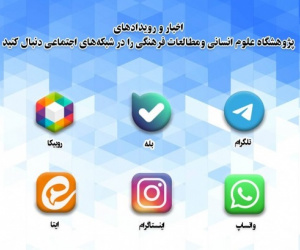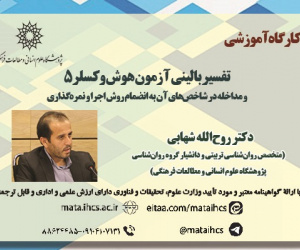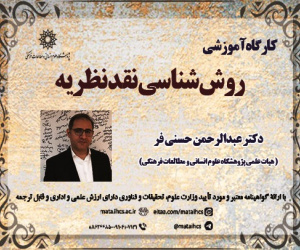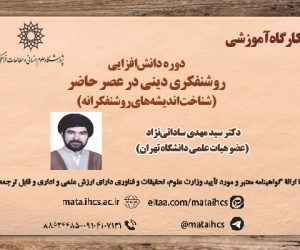تدوین برنامه درسی هوش اخلاقی کودکان پیش از دبستان براساس نظریه بوربا (مقاله علمی وزارت علوم)
درجه علمی: نشریه علمی (وزارت علوم)
آرشیو
چکیده
هدف پژوهش حاضر، تدوین برنامه درسی هوش اخلاقی کودکان پیش از دبستان براساس نظریه بوربا است. پژوهش حاضر از بعد هدف، کاربردی و از بعد کمیت، پژوهشی کمی که با روش توصیفی-پیمایشی است. جامعه آماری پژوهش، شامل کلیه متخصصان علوم تربیتی و روانشناسی است که در مراکز آموزش عالی کشور مشغول به تدریس می باشند (510 نفر) است که اسامی آن ها از طریق سایت وزارت علوم و تحقیقات و فناوری کشور مشخص شد. و 200 نفر به صورت نمونه گیری هدفمند ( کسانی که در حوزه هوش اخلاقی کار تحقیقاتی داشتند و کسانی حوزه علاقه انها کودک بود) انتخاب شده اند و تعداد 180 نفر به پرسشنامه محقق ساخته پاسخ دادند. ابزار پژوهش، پرسشنامه محقق ساخته است که روایی آن 85% به دست آمد. پایایی ابزار با استفاده از ضریب آلفای کرونباخ 98% به دست آمد. تجزیه وتحلیل داده های پژوهش در سطح آمار توصیفی با استفاده از نرم افزار SPSS و روش الگویابی معادلات ساختاری با استفاده از نرم افزار 23 AMOS انجام گرفت. نتایج به دست آمده از تحلیل عاملی تأییدی مرتبه دوم نشان می دهد که ضرایب استاندارد میزان سنجش برنامه درسی هوش اخلاقی به وسیله اهداف، محتوا، فرایند یاددهی- یادگیری و ارزشیابی به ترتیب برابر با 72/0، 94/0، 76/0، و 90/0 است و چون سطح معناداری برابر 001/0 کوچک تر از سطح معنا داری 05/0=α است. بنابراین قدرت رابطه بین عامل (برنامه درسی هوش اخلاقی) و مؤلفه های قابل مشاهده که هرکدام از این مؤلفه ها خود براساس نظریه بوربا دارای هفت زیر مؤلفه می باشند، سنجیده شده اند دارای وضعیت خیلی مطلوب است..Compilation of moral intelligence curriculum for pre-primary school children based on Burba's theory
The aim of the current research is to compile the moral intelligence curriculum of pre-primary school children based on Borba's theory. The current research is practical from the objective aspect and from the quantitative aspect, it is a quantitative research that was conducted with a descriptive-survey method in order to answer and collect the research data. . The statistical population of the research includes all educational and psychology specialists who are teaching in the country's universities (510 people), whose names were identified through the website of the Ministry of Science, Research and Technology. And 200 people have been selected by purposeful sampling and 180 people answered the researcher-made questionnaire. The research tool is a questionnaire made by the researcher, and the opinions of five professors of Shahid Bahonar University of Kerman were used to determine the validity of the questionnaire, and the validity of the questionnaire was 85%. In order to calculate and measure the reliability of the research tool, Cronbach's alpha coefficient was used and the reliability of the research tool was 98%. Analysis of research data at the level of descriptive statistics (prevalence, mean, standard deviation, minimum, maximum, table and graph, skewness and kurtosis, Mahalanobis test) using SPSS software and structural equation modeling method using AMOS 23 software. took The results obtained from the second-order confirmatory factor analysis show that the standard coefficients of the measurement of moral intelligence curriculum by objectives, content, teaching-learning process and evaluation are equal to 0.72, 0.94, 0.76, and 0.90 respectively. is 0 and because the significance level is equal to 0.001, it is smaller than the significance level of α=0.05. Therefore, the strength of the relationship between the agent (the curriculum of moral intelligence) and the visible components (goals, content, teaching-learning process and evaluation), each of these components, based on Borba's theory, has seven sub-components (common features, empathy, self-control, conscience, respect, (fairness and tolerance) are considered to have a very favorable status. Therefore, it can be said that these four components and its sub-components have been able to measure the hidden variable well. Keywords: Curriculum compilation, moral intelligence, child, preschool, Borba's theory. Abstract The aim of the current research is to compile the moral intelligence curriculum of preschool children based on Barba’s theory. The method of the present research is descriptive-survey and the statistical population of the research includes all the specialists in educational sciences and psychology (510 people) who are teaching in the higher education centers of the country. of which 200 people have been selected by purposeful sampling. The research tool is a researcher-made questionnaire, the validity of which was 85%. The reliability of the tool was obtained using Cronbach's alpha coefficient of 98%. Analysis of the research data was done at the level of descriptive statistics using SPSS software and structural equation modeling method using AMOS 23 software. The obtained results show that the standard coefficients of measuring the moral intelligence curriculum by means of goals, content, teaching-learning process and evaluation are equal to 0.72, 0.94, 0.76, and 0.90, respectively, and because the significance level is equal to 0.001 is less than the significance level of α=0.05. Therefore, the strength of the relationship between the factor (the curriculum of moral intelligence) and the observable components, each of which has been measured based on Barba’s theory, has seven sub-components, has a very favorable condition. Keywords: curriculum development, moral intelligence, child, preschool, Barba’s theory. Introduction The first years of a child's life are considered one of the most important periods of his development, and what happens during thi







